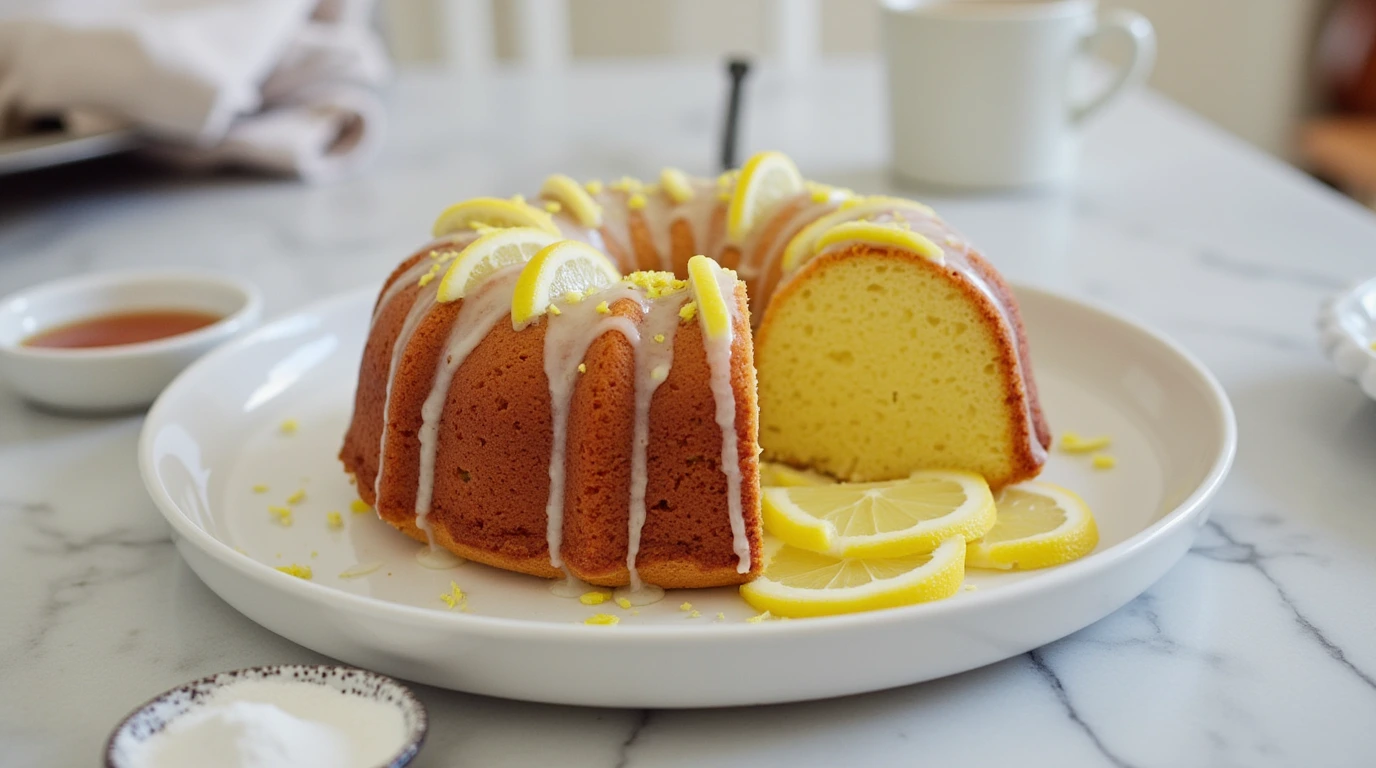A gluten free lemon pound cake is the perfect combination of a buttery, dense texture and refreshing citrus flavor. This classic recipe uses gluten free ingredients to achieve a tender crumb that’s indistinguishable from the traditional version. Whether you’re hosting a brunch or craving an everyday treat, this cake delivers.
For a delightful start to your day, pair this pound cake with a sweet gluten free breakfast casserole for a balanced and satisfying breakfast spread.
Why This Lemon Pound Cake Stands Out
This cake shines because of its simplicity and adaptability. The use of butter and cream cheese creates a rich and moist texture, while the fresh lemon juice and zest add a bright and tangy flavor. It’s perfect for special occasions or as a light dessert for afternoon tea.
Looking for more options to expand your gluten free baking repertoire? Try this healthy gluten free breakfast cake loaf, another versatile treat that complements any meal.
Ingredients You’ll Need
Here are the essentials for creating this luscious cake:
- Gluten Free Flour Blend: 1 ¼ cups (175g). Ensure your flour includes xanthan gum for proper structure.
- Cornstarch: ¼ cup (36g) for a tender crumb.
- Butter: 12 tbsp (168g) unsalted, softened.
- Cream Cheese: 4 oz (113g), softened.
- Sugar: 1 cup (200g) granulated sugar.
- Eggs: 4 large, room temperature.
- Lemon Juice: 2 tbsp freshly squeezed.
- Lemon Zest: Zest of 1 large lemon for bold citrus flavor.
Step-by-Step Instructions
1. Prepare the Pan and Ingredients
- Preheat your oven to 325°F (160°C).
- Grease and line a 9-inch loaf pan with parchment paper.
- Grate the zest and juice the lemons.
2. Make the Batter
- Cream butter and cream cheese until smooth and fluffy.
- Gradually add sugar, then beat in the eggs one at a time.
- Mix in the lemon juice and zest.
- Gently fold in the gluten free flour blend, cornstarch, and salt.
3. Bake
- Pour the batter into the prepared pan.
- Bake for 50–60 minutes. Cover with foil if the top browns too quickly.
- Test with a toothpick; it should come out clean.
4. Lemon Glaze
- Combine 1 ½ cups powdered sugar with 1 tbsp lemon juice. Drizzle over the cooled cake.
-
Storage Tips
Proper storage ensures your gluten free lemon pound cake retains its moisture and flavor, whether you plan to enjoy it immediately or save it for later. Follow these detailed storage tips to keep your cake fresh and delicious:
1. Room Temperature
- Duration: Store at room temperature for up to 2 days.
- Best Practices:
- Use an airtight container or wrap the cake tightly in plastic wrap to prevent it from drying out.
- Store in a cool, dry place away from direct sunlight and heat sources, which can cause the glaze to melt.
- Tip: If you live in a humid environment, refrigeration may be a better option to prevent spoilage.
2. Refrigeration
- Duration: Keeps fresh in the refrigerator for up to 5 days.
- Best Practices:
- Wrap the cake in plastic wrap or foil before placing it in an airtight container to lock in moisture and protect it from fridge odors.
- Allow the cake to come to room temperature for 20–30 minutes before serving for the best flavor and texture.
- Tip: Refrigerated pound cake develops a slightly denser texture, which some find even more enjoyable!
3. Freezing
- Duration: Freeze for up to 3 months.
- Freezing Process:
- Slice the cake into individual portions for convenience.
- Wrap each slice tightly in plastic wrap to prevent freezer burn.
- Place the wrapped slices in a freezer-safe bag or container, and label with the date for easy tracking.
- Thawing Instructions:
- For best results, thaw slices in the refrigerator overnight.
- Alternatively, let them sit at room temperature for about 1–2 hours.
- Warm slightly in the microwave for a freshly baked feel.
Additional Tips for Storage
- Glaze Separately: If you plan to freeze the cake, consider freezing it without the glaze and adding it after thawing for a fresher appearance.
- Portion Control: Freezing individual slices makes it easy to enjoy a small serving without defrosting the entire cake.
- Travel-Friendly: If transporting the cake, keep it wrapped tightly to prevent it from drying out during the journey.
FAQs
1. Can I Make This Dairy-Free?
Yes, this recipe can easily be adapted for a dairy-free version without losing its moist texture or rich flavor.
- Substitute for Butter: Use vegan butter or coconut oil for a dairy-free alternative.
- Substitute for Cream Cheese: Opt for dairy-free cream cheese or silken tofu blended with a splash of lemon juice to mimic the tanginess.
- Pro Tip: Ensure all replacements are unsalted to maintain flavor balance.
2. How Do I Make the Cake More Lemon-Flavored?
For a stronger lemon punch, you can enhance the citrus notes in multiple ways:
- Increase the Zest: Use the zest of 2 lemons instead of 1 for a more robust aroma.
- Add Lemon Extract: Include 1 teaspoon of lemon extract for a concentrated citrus flavor.
- Infused Sugar: Mix the lemon zest with the sugar and let it sit for 10–15 minutes to release natural oils before creaming.
3. Can I Use Almond Flour Instead?
While almond flour is a popular gluten free option, this recipe is designed for a blend that includes starch for structure. If you prefer almond flour:
- Adjust Liquids: Reduce the liquid slightly as almond flour absorbs less moisture.
- Test Batch: Try a small batch first to perfect the texture.
For an easier alternative, try this gluten free pumpkin bread, which uses a balanced gluten free flour blend.
4. What’s a Good Alternative for Cream Cheese?
If you don’t have cream cheese on hand, here are a few substitutes:
- Sour Cream: Adds moisture and a slight tang, similar to cream cheese.
- Greek Yogurt: Thick and creamy, it works well while keeping the cake light.
- Mascarpone: A less tangy but equally rich option.
For a dessert with sour cream as a key ingredient, explore this recipe for gluten free sour cream coffee cake muffins.
5. How Can I Prevent My Cake From Being Too Dense?
A dense cake is often the result of overmixing or using cold ingredients. Avoid these pitfalls:
- Room Temperature Ingredients: Ensure butter, cream cheese, and eggs are at room temperature for easy incorporation.
- Gentle Mixing: Mix just until ingredients are combined; overmixing can overdevelop the batter, resulting in a dense texture.
- Proper Measurements: Use a kitchen scale to measure dry ingredients precisely, as too much flour can weigh down the cake.
6. Can I Freeze This Cake?
Yes, freezing this pound cake is an excellent way to extend its shelf life:
- How to Freeze: Wrap the cooled cake tightly in plastic wrap and place it in a freezer-safe bag. Alternatively, slice the cake and wrap each piece individually for easier serving.
- Storage Duration: Freeze for up to 3 months.
- Thawing Instructions: Let the cake thaw in the refrigerator overnight or at room temperature for 2–3 hours before serving.
7. What’s the Best Way to Glaze the Cake?
The glaze adds the finishing touch to this lemon pound cake. To ensure perfection:
- Cool the Cake: Let the cake cool completely before applying the glaze to avoid it melting.
- Drizzle in Layers: Apply the glaze in two layers for better coverage and presentation.
- Adjust Thickness: If the glaze is too thin, add more powdered sugar. If too thick, thin it with a few drops of lemon juice.
8. Can I Make Mini Pound Cakes?
Yes, this recipe works well in smaller molds like muffin tins or mini loaf pans:
- Baking Time: Reduce the baking time to 20–25 minutes and check for doneness with a toothpick.
- Perfect for Gifting: Mini pound cakes make delightful gifts for friends and family.
This gluten free lemon pound cake is a versatile and crowd-pleasing dessert. Serve it with tea or coffee for an indulgent treat, or top with fresh berries for a vibrant twist! For a more traditional flavor profile, explore this gluten free pound cake recipe and compare the results.

